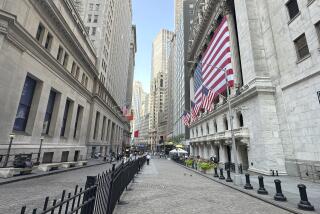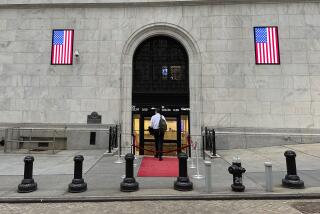SEC proposes new circuit-breaker mechanism to prevent another ‘flash crash’
- Share via
Reporting from Washington — In an attempt to prevent a repeat of this month’s rapid market plunge, the Securities and Exchange Commission on Tuesday proposed a new circuit-breaker mechanism that would briefly halt trading in individual stocks that experience a 10% price change over a five-minute period.
The move came as the SEC and the Commodity Futures Trading Commission said they still had not determined exactly what caused the Dow Jones industrial average to plummet 700 points in just 15 minutes on May 6. In a 151-page report released Tuesday, the agencies said they were focused on six areas as they continued to collect and analyze huge amounts of information.
Among the potential causes were the “severe mismatch in liquidity” during the May 6 crash; the impact of stop-loss and other market orders; and the possible link between the steep decline in stock index products, such as funds and futures, with “simultaneous and subsequent waves of selling in individual securities.”
The report of their preliminary findings stressed that reconstructing the extremely high-volume trading during the so-called flash crash is “an enormous undertaking.” There were 66 million trades that day — including 17 million in the most volatile hour — totaling 19.4 billion shares, more than twice the recent average daily trading volume.
Although investigators have found no evidence that the crash was caused by hackers, terrorists or a so-called fat-finger trader who accidentally placed an extremely large stock order, “we cannot completely rule out these possibilities,” the report said.
SEC Chairwoman Mary Schapiro said that different trading rules across exchanges exacerbated the May 6 crash and the new circuit breakers are designed to address that.
The proposal would enact a five-minute trading pause for stocks in the Standard & Poor’s 500 index. If the commission approves the circuit breaker, as expected, after a 10-day public comment period, the new rules would be in place on a pilot basis until Dec. 10.
The SEC said it hoped to use that time to make adjustments to the mechanism and to expand it to other stocks, including exchange traded funds, “as soon as practicable.”
The move was agreed to by the leaders of six major financial exchanges during a meeting last week with Schapiro after the market nose dive.
The New York Stock Exchange enacted circuit breakers after a major market crash in 1987. But those are based on movement of the Dow, not individual stocks, and enact a market-wide trading halt. The halt kicks in only after the Dow drops at least 10% before 11:30 a.m. PDT. The May 6 plunge happened later in the day and did not reach 10%, making those circuit breakers useless in halting trading.
“I believe that circuit breakers for individual securities across the exchanges would help to limit significant volatility,” Schapiro said Tuesday. “They would also increase market transparency, bolster investor protection and bring uniformity to decisions regarding trading halts in individual securities.”
The SEC also is working with exchanges to revise the NYSE’s market-wide circuit breakers. In addition, Schapiro has asked the SEC staff to look at other preventive measures for large, fast-moving market shifts.
One focus will be steps to deter or ban the use of “stub quotes,” which are placeholder prices put on stocks when liquidity in the market dries up. Those quotes allowed some major stocks to sell for pennies during the May 6 crash even though it’s unlikely anybody placed orders to buy at such low prices.
Rep. Paul Kanjorski (D-Pa.), who chaired a House subcommittee hearing on the May 6 crash last week, praised the SEC and other market participants for moving promptly to try to avoid a repeat.
“While it is far too soon to determine whether the proposals … will prove sufficient to protect investors and to shelter our markets from sudden, drastic technology-driven swings in our markets, they are an important first step,” he said. “As our markets have become more fragmented, seeking to more adequately integrate them through uniform rules seems both prudent and wise.”
The NYSE also applauded the proposal for circuit breakers on individual stocks, which it described as “a meaningful step towards reaffirming the integrity of, and confidence in, America’s capital market system.”
The Securities Industry and Financial Markets Assn., which represents securities firms, banks and asset managers, was less enthusiastic. The group said it appreciated the SEC’s decision to test the new circuit breakers on a pilot basis, which will be an opportunity to “fine-tune them” to avoid “unintended, adverse consequences to our markets or investors.”
The preliminary investigation findings released Tuesday will be sent to members of the new Joint CFTC-SEC Advisory Committee on Emerging Regulatory Issues, which will discuss the crash at its first meeting next week. The group will review the market plunge and make additional recommendations about how to prevent a repeat.
The panel is jointly headed by Schapiro and CFTC Chairman Gary Gensler, and includes Nobel Prize-winning economist Joseph Stiglitz of Columbia University, former CFTC Chairwoman Brooksley Born, former SEC Chairman David Ruder and former Vanguard Group Chief Executive Jack Brennan.
Times staff writer Nathaniel Popper in New York contributed to this report.
More to Read
Inside the business of entertainment
The Wide Shot brings you news, analysis and insights on everything from streaming wars to production — and what it all means for the future.
You may occasionally receive promotional content from the Los Angeles Times.











